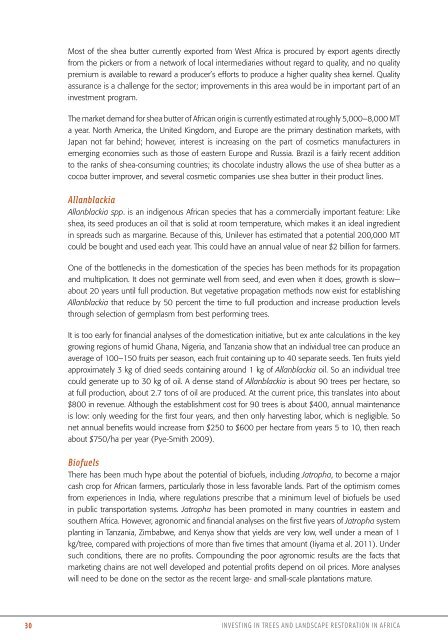INVESTING IN TREES AND LANDSCAPE ... - PROFOR
INVESTING IN TREES AND LANDSCAPE ... - PROFOR
INVESTING IN TREES AND LANDSCAPE ... - PROFOR
Create successful ePaper yourself
Turn your PDF publications into a flip-book with our unique Google optimized e-Paper software.
Most of the shea butter currently exported from West Africa is procured by export agents directly<br />
from the pickers or from a network of local intermediaries without regard to quality, and no quality<br />
premium is available to reward a producer’s efforts to produce a higher quality shea kernel. Quality<br />
assurance is a challenge for the sector; improvements in this area would be in important part of an<br />
investment program.<br />
The market demand for shea butter of African origin is currently estimated at roughly 5,000–8,000 MT<br />
a year. North America, the United Kingdom, and Europe are the primary destination markets, with<br />
Japan not far behind; however, interest is increasing on the part of cosmetics manufacturers in<br />
emerging economies such as those of eastern Europe and Russia. Brazil is a fairly recent addition<br />
to the ranks of shea-consuming countries; its chocolate industry allows the use of shea butter as a<br />
cocoa butter improver, and several cosmetic companies use shea butter in their product lines.<br />
Allanblackia<br />
Allanblackia spp. is an indigenous African species that has a commercially important feature: Like<br />
shea, its seed produces an oil that is solid at room temperature, which makes it an ideal ingredient<br />
in spreads such as margarine. Because of this, Unilever has estimated that a potential 200,000 MT<br />
could be bought and used each year. This could have an annual value of near $2 billion for farmers.<br />
One of the bottlenecks in the domestication of the species has been methods for its propagation<br />
and multiplication. It does not germinate well from seed, and even when it does, growth is slow—<br />
about 20 years until full production. But vegetative propagation methods now exist for establishing<br />
Allanblackia that reduce by 50 percent the time to full production and increase production levels<br />
through selection of germplasm from best performing trees.<br />
It is too early for financial analyses of the domestication initiative, but ex ante calculations in the key<br />
growing regions of humid Ghana, Nigeria, and Tanzania show that an individual tree can produce an<br />
average of 100–150 fruits per season, each fruit containing up to 40 separate seeds. Ten fruits yield<br />
approximately 3 kg of dried seeds containing around 1 kg of Allanblackia oil. So an individual tree<br />
could generate up to 30 kg of oil. A dense stand of Allanblackia is about 90 trees per hectare, so<br />
at full production, about 2.7 tons of oil are produced. At the current price, this translates into about<br />
$800 in revenue. Although the establishment cost for 90 trees is about $400, annual maintenance<br />
is low: only weeding for the first four years, and then only harvesting labor, which is negligible. So<br />
net annual benefits would increase from $250 to $600 per hectare from years 5 to 10, then reach<br />
about $750/ha per year (Pye-Smith 2009).<br />
Biofuels<br />
There has been much hype about the potential of biofuels, including Jatropha, to become a major<br />
cash crop for African farmers, particularly those in less favorable lands. Part of the optimism comes<br />
from experiences in India, where regulations prescribe that a minimum level of biofuels be used<br />
in public transportation systems. Jatropha has been promoted in many countries in eastern and<br />
southern Africa. However, agronomic and financial analyses on the first five years of Jatropha system<br />
planting in Tanzania, Zimbabwe, and Kenya show that yields are very low, well under a mean of 1<br />
kg/tree, compared with projections of more than five times that amount (Iiyama et al. 2011). Under<br />
such conditions, there are no profits. Compounding the poor agronomic results are the facts that<br />
marketing chains are not well developed and potential profits depend on oil prices. More analyses<br />
will need to be done on the sector as the recent large- and small-scale plantations mature.<br />
30 <strong><strong>IN</strong>VEST<strong>IN</strong>G</strong> <strong>IN</strong> <strong>TREES</strong> <strong>AND</strong> L<strong>AND</strong>SCAPE RESTORATION <strong>IN</strong> AFRICA

















